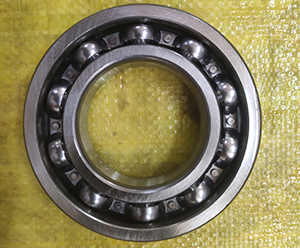
How to measure a bearing
Measuring a bearing accurately is crucial for identifying the correct replacement or determining the appropriate size for a new application. Here’s a step-by-step guide on how to measure a bearing:
1. Clean the Bearing: Ensure the bearing is free from dirt, debris, or lubricant buildup that could affect measurements. Use a solvent or cleaning solution and a lint-free cloth to clean the bearing surfaces thoroughly.
2. Identify the Type of Bearing: Before measuring, determine whether the bearing is a ball bearing, roller bearing (such as cylindrical, tapered, or spherical), or a plain bearing (bushing). Different types of bearings may require slightly different measurement methods.
3. Measure the Inner Diameter (ID): Similarly, measure the inner diameter of the bearing using a caliper or micrometer. Position the measuring tool across the inner race for ball bearings or the inner ring for roller bearings. Record the measurement in millimeters (mm).
4. Measure the Outer Diameter (OD): Use a caliper or micrometer to measure the outer diameter of the bearing. Place the measuring tool across the widest point of the outer race for ball bearings or the outer ring for roller bearings. Record the measurement in millimeters (mm).
5. Measure Multiple Points: Bearings may not always be perfectly round or symmetrical due to manufacturing variations or wear. To account for this, measure multiple points around the bearing’s circumference or width and take the average of these measurements to ensure accuracy.
6. Use Proper Measuring Tools: Ensure you use appropriate measuring tools for the job, such as calipers, micrometers, or dial indicators. Choose tools that provide the necessary precision and accuracy for the size of the bearing you’re measuring. Avoid using worn or damaged measuring instruments that could compromise the accuracy of your measurements.
7. Seek Professional Assistance if Needed: If you encounter difficulties or uncertainties during the measurement process, don’t hesitate to seek assistance from bearing manufacturers, distributors, or experienced engineers. They can provide guidance on proper measurement techniques, interpretation of measurements, and selection of suitable bearings for your application.
8. Consider Bearing Fit: When measuring bearings for replacement, it’s essential to consider the fit between the bearing and its housing or shaft. Measure the dimensions of the housing or shaft to ensure compatibility with the bearing’s size and fit tolerance. Refer to bearing fit charts or engineering standards to determine the appropriate fit for your application.
9. Consider Environmental Factors: Take into account any environmental factors that may affect the bearing’s performance or dimensions. For example, temperature variations can cause thermal expansion or contraction, which may impact the bearing’s size. Measure the bearing under normal operating conditions if possible, or account for any expected changes in dimension due to environmental factors.
10. Maintain Measurement Records: Keep records of your bearing measurements for future reference, maintenance, or troubleshooting purposes. Having a comprehensive database of bearing dimensions and specifications can streamline the process of selecting replacements and ensuring proper fit and performance in the long run.
11. Check for Additional Dimensions (for Roller Bearings): Depending on the type of roller bearing, additional dimensions may need to be measured. For example, tapered roller bearings require measurements of the cone (inner) and cup (outer) widths, while spherical roller bearings may require measurements of the bore diameter, outside diameter, and width.
12. Determine the Width (or Thickness): For ball or roller bearings, measure the width or thickness of the bearing. Place the measuring tool perpendicular to the bearing’s axis and record the measurement in millimeters (mm).
13. Refer to Manufacturer Specifications: Compare your measured dimensions with the manufacturer’s specifications for the bearing. These specifications can typically be found in product datasheets or technical manuals provided by the manufacturer. Ensure that your measurements fall within the acceptable tolerances specified by the manufacturer.
14. Consider Special Features: Take note of any special features or configurations of the bearing, such as flanges, seals, or shields. These features may affect the bearing’s dimensions and compatibility with your application.
15. Verify Accuracy: Double-check your measurements to ensure accuracy, especially if precise sizing is critical for your application. Repeat measurements if necessary to ensure consistency.
16. Document Measurements: Record your measurements along with any relevant information, such as bearing type, part number (if available), and special features. This documentation will be valuable for selecting the correct replacement or specifying the right bearing for a new application.
By following these steps and taking accurate measurements, you can effectively determine the size and specifications of a bearing, ensuring proper fit and performance in your application.
NSAR group company and have our own factories overseas
NSAR bearings management team of managers, engineers, and technical staff have 15 – 25 years experience. We supply customers with bearings not only produced in our own factory, but also produced in professional bearings plants designated by NSAR brand to meet customers’ different requirements, such as pillow block bearings,we have designated a factory in northern China, which has perfect testing equipment and can develop products to customer needs very rapidly. Miniature bearings are arranged in the factory in southern China, which has enjoyed a good reputation long term in producing miniature bearings.
As a professional factory that produces professional products, with professional people doing professional things, our foreign customers have declared: “NSAR bearings have reached a domestic first-class and international brand-name quality, and NSAR bearing prices are 30-50% lower than international similar bearings.”
NSAR, as best 6300 bearings supplier, wholesale deep groove ball bearings, inlcuding wholesale 6308 bearings, wholesale 6307 bearing, 6306 bearings, wholesale 6305 bearing, 6304 bearings, 6302 bearings, 6309 bearings, 6311 bearings and deep groove ball bearings for household appliance and micro-motors supplies wholesale needs,products download.
These are just a few examples of companies in China that manufacture deep groove ball bearings. It’s important to conduct thorough research and consider factors such as product quality, reliability, and pricing when selecting a supplier.

